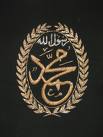Some people allege that there was no methodology for recording Hadith, especially during the Prophet's lifetime, and accordingly, this casts doubt about the authenticity of the science of Hadith and Sunnah in general.
As far as the first method is concerned, the Prophet used to repeat important things three times and then listen to what the Companions had learned from him. The second method includes all the letters of the Prophet to kings inviting them to Islam, and to Muslim governors detailing the rules of zakah and other legal matters. Likewise, the Prophet taught his Companions how to perform ablution, prayer, fasting, pilgrimage, and so on. This represents the third method of teaching the Sunnah by the Prophet.
The Companions played an important role in learning and teaching the Hadith of the Prophet. They used all the three methods applied by the Prophet to teach the Sunnah, and they committed hadiths of the Prophet to memory.
Writing Down of the Hadith (Tadwin Al-Hadith)
In Hadith literature, we are faced with hadiths that forbid and others that permit the writing down of hadiths.
Abu Sa`id Al-Khudri reported a hadith that forbids the writing down of hadiths: “Do not write from me anything except the Qur’an and whosoever has written anything from me other than the Qur’an should erase it.”
This is the only sound hadith in this regard. Other often-quoted hadiths that forbid the writing down of hadiths are weak and unacceptable. The above mentioned hadith is recorded in Al-Bukhari, and according to him it is the statement of Abu Sa`id Al-Khudri himself. The hadith meant that nothing should be written with the Qur’an on the same sheet, as this might lead to mixing the text of the Qur’an with that of the Hadith. This command was given when the Qur’an was being revealed bit by bit and was yet incomplete.
Another interpretation of the hadith is that it was forbidden to write down hadiths in early days because all attention was to be paid to the Qur’an and its preservation. Then later on, when there was no fear of abandoning the Qur’an, the previous order was abrogated and the Companions were permitted to write down hadiths. On the other hand, we have evidence that the Prophet approved of writing down his hadiths.
We find that many Companions recorded hadiths. For example, `Abdullah ibn `Amr was permitted and even encouraged by the Prophet (peace and blessings be upon him) to write down Hadith. In addition, some 50 Companions and many followers are said to have possessed manuscripts (sahifah, Arabic plural suhuf), which was used as a term to designate compendia of Hadith that emerged during the century before the formation of the classical collections. The original manuscripts have been lost, but a very few copies have survived. An example is the manuscript of Hammam ibn Munabbih, who learned from Abu Hurairah and from him he wrote his manuscript which contains 138 hadiths. This manuscript is believed to have been written down around the middle of the first century after the Hijrah (seventh century CE).
In the beginning of the second Hijri century, during the reign of `Umar ibn `Abdul-`Aziz (AH 97-101/715-19 CE) the texts of Hadith were committed to writing. The Sunnah was collected in Syria, Egypt, Iraq, Yemen, and Khurasan. Leading theologians uttered some statements warning against unscrupulous reporters and their unreliable reports.
Imam Malik (d. AH 179/795 CE) was the first to undertake the comprehensive and systematic compilation of Hadith. His work is known as Al-Muwatta’ (The Trodden Path). Later, other compilations came into existence.
In this regard, it is very important to note that there are two kinds of compilations:musnad and musannaf. Inmusnad collections, hadiths are arranged alphabetically under the names of the Companions on whose authority these hadiths were reported. An example of this kind is theMusnad of Ibn Hanbal (d. AH 241/855 CE).
In musannaf collections, hadiths are recorded under various headings dealing with juridical subjects such as As-Sihah As-Sittah (The Six Authentic Books of Hadith), namely the compilations of Al-Bukhari (d. AH 256/870 CE), Muslim (d. AH 261/874 CE), An-Nasa’i (d. AH 303/916 CE), Abu Dawud (d. AH 275/889 CE), At-Tirmidhi (d. AH 279/892 CE), and Ibn Majah (d. AH 273/886 CE).
Evolution of the Science of Hadith
As time passed, many hadiths appeared due to several reasons. Some of these hadiths were not authentic. Therefore, it was quite necessary to sift out the authentic from the fabricated. One can say that this task was as necessary as that of removing the weeds from a flower bed. To be sure, the task was not that easy for early scholars to develop a tool by which they could regulate such immense Hadith literature.
It should be observed that the rules and criteria developed by Hadith scholars regulating their study of Hadith were meticulous, but some of their terminology varied from person to person, and their principles began to be systematically written down, but scattered among various books, for example, the Risalah of Ash-Shafi`i, the introduction to theSahih of Muslim, and the Jami`of At-Tirmidhi. Many of the criteria of early Hadith scholars, such as Al-Bukhari, were deduced by later scholars from a careful study of which reporters or isnads (chains of transmission) were accepted or rejected by them.
In this way the science of Hadith (mustalah al-hadith) emerged. It was the purpose of this science to sift, organize, develop, and systemize earlier material. Scholars put forward theories, expanded biographical works of all generations, made full and well-defined classification of narrators and hadiths, and subjected works of leading compilers to vigorous scrutiny, sparing not even Al-Bukhari and Muslim.
Courtesy: http://www.islamonline.net/servlet/Satellite?c=Article_C&cid=1158658454996&pagename=Zone-English-Living_Shariah/LSELayout


.jpg)





Post a Comment